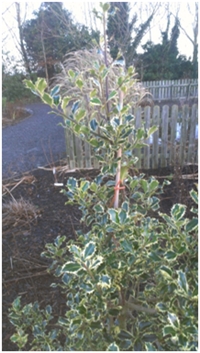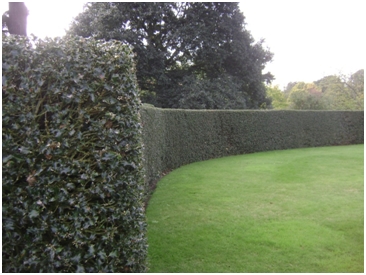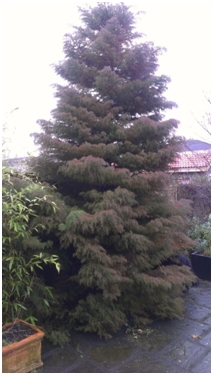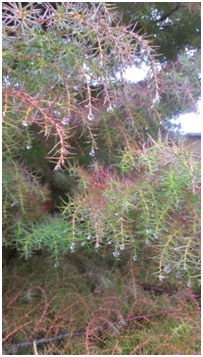Holly, Ilex aquifolium is one of the few native evergreens that we have. It and its variants can hold their own in the garden against all the foreign competition. Being native they, survived the last hard winter, though some damage was done in colder areas (as there was to our native ivy, and also gorse which was badly damaged or even killed outright)
Hollies are generally regarded as shrubs and treated as such, and get cut back and end up as shapeless blobs. They never fulfil their true potential. Hollies should be thought of as trees, even when planted out as small shrubs. When I plant a holly, I always picture it as a pyramidal tree of five metres plus tall, and in time it will be. And it doesn’t take as much time as you may think. When hollies are planted into good rich, well improved soil, after settling in, their growth can be quite fast. I’ve got 60 cms of growth in a season from hollies!
The other thing about growing hollies, which is even more important, is their proper training, and this is where gardeners fall down the most (professional as well as amateur). Hollies should have a single leading shoot, which in time will give a single trunk. Forks should not be allowed develop. When a holly gets big it should have a pleasing pyramidal shape, with all branches radiating from a single axis. If need be, bottom branches can be stripped to make a standard, but I think holly is best clothed right to the ground.

Holly trained up to form a leader
Sometimes a holly will be single stemmed when planted and so it does all the training itself. But usually there are a number of branches of equal prominence and one will have to be selected out. This shoot can be tied up to a bamboo cane to help things along. A holly when growing strongly will hold its leader well, and just a bit of fine tuning with secateurs is needed now and again.
Some people might say that this is too much attention to detail to the point of nit picking, and plants should be grown as nature intended. This is to misunderstand the nature of gardening, which is about interfering to a lesser or greater extent with nature.
Holly makes a great (if gardener unfriendly) hedge but best not used when bordering onto areas needing hand weeding, – you can’t always be wearing gloves! For those areas, the holly-like evergreen oak is preferable. See below photo from Kew Gardens of their magnificent holly hedge.

Holly hedge at Kew in September
Female hollies are most common than males in the trade as most people want a holly that will berry. The two varieties of holly we were familiar with years ago were the male ‘Silver Queen’ and the female ‘Golden King’ ( A female king and a male queen – they were ahead of themselves in some ways back then!)
‘Golden King’ is very popular, but just a little dull for me, almost brownish, and the berries don’t show up particularly well. It is one variety that usually needs early training as it is inclined to grow outwards, so it’s rare to see a good specimen of it. ‘
Silver Queen’ is very beautiful, with a proper spiky holly leaf, and ideal as a pollinator. ‘Aurea Marginata’ is similar but female.
‘J. C. van Tol’ is popular because it’s self fertile, but its almost spineless leaves don’t appeal to me.
‘Lawsoniana’ is interesting because it has the variegation on the inside, but it is a woeful reverter.
‘Madame Briot’ is golden like ‘Golden King’ but not dull at all. It should be used more.
There is a kind of freak show look to the hedgehog holly with spines all over the leaves – a ‘collector’s plant’ is the put down term often used for such plants. But the variegated form of the hedgehog holly ‘Ferox Argentea’ is surprisingly attractive. It’s painfully slow growing, and hard to get it on a single leader, but well worth the trouble.
P.S. Another plant which is particularly good on a single lead, and rarely seen that way (in fact rarely seen much these days ) is Cryptomeria japonica ‘Elegans’. When it is multi stemmed, it makes a wide untidy bush, but completely different and very elegant on a single trunk. Its soft juvenile foliage, which goes a lovely bronze in winter, makes a great contrast to other leaf colours. It gets our no conifer policy in our gardens, along with yews, Thuja ‘Emerald’, and almost any member of the pine family.


Cryptomeria japonica ‘Elegans’ Cryptomeria japonica ‘Elegans’ foliage in the rain
Source: HortiTrends News Room





